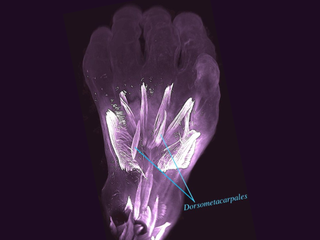- UID
- 20
- Online time
- Hours
- Posts
- Reg time
- 24-8-2017
- Last login
- 1-1-1970
|
|
━━━━━━━━━━━━━━━━━
Detailed 3D images of embryos reveal that some muscles form and then vanish during early human development.

The hand of a 10-week-old human embryo with atavistic (relating to an ancestor) muscles called dorsometacarpales labeled.(Image: © Rui Diogo, Natalia Siomava and Yorick Gitton)
▼ In the womb, developing humans grow extra muscles in their hands and feet that later disappear without a trace, scientists have discovered.
The temporary tissues, the researchers found, may be leftovers from our evolutionary ancestors.
The mysterious musclescan be found in limbed animals with more dexterous digits than ours, explained study co-author Rui Diogo, an evolutionary biologist and hominid paleobiologist at Howard University in Washington, D.C. Many of the muscles crop up in lizards, which sport fantastically wiggly toes, while a couple of them appear in mammals like chimpanzees, known for their flexible feet. However, in humans, the tissues either fuse to other muscles or shrink away to nothing before birth, according to the small study, published Oct. 1 in the journal Development.
The authors suggest that some of the transient muscles may have vanished from our adult ancestors more than 250 million years ago, as mammals began evolving from mammal-like reptiles. Given the study's small sample size, though, it remains to be seen whether these muscles appear in all human embryos and what that may mean for human evolutionary history.
"To me, the main [takeaway] is this idea that we have supernumerary muscles that are just transient, and then they are gone," said Alain Chédotal, a neuroscientist and developmental biologist at the Pierre and Marie Curie University in Paris, who was not involved in the work. The study needs to be replicated on a larger scale before any "big conclusions" can be drawn, Chédotal stressed, but the preliminary results pose interesting questions about prenatal development.
The muscles "were present [in the developing embryos] and then they were not, but then in-between, there's something that's not known," he said. "What is inducing this disappearance of the muscles?"
Looking under the skin
Though Chédotal was not involved in the current research, data from (▪ ▪ ▪)
► Please, continue reading this article here: Source |
|